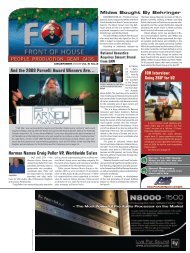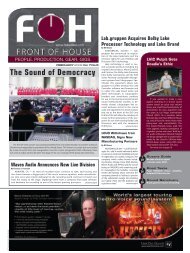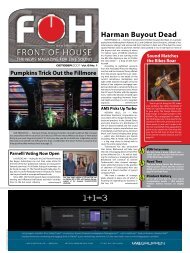You also want an ePaper? Increase the reach of your titles
YUMPU automatically turns print PDFs into web optimized ePapers that Google loves.
48<br />
Sound Sanctuary<br />
Putting on the<br />
By JamieRio<br />
Righteous Squeeze<br />
I<br />
have spent the last few months going<br />
over the basics of HOW sound systems.<br />
All of you have varied levels of proficiency<br />
with regard to your sound technician skills;<br />
however, going over basic principles is a<br />
good thing. Do you ever ask why your priest,<br />
pastor, rabbi, etc., has gone over some of the<br />
basic tenants of your particular religion more<br />
than once? Their purpose is to build a strong<br />
foundation for your faith. Well, it’s the same<br />
in worship sound. Obviously, not as lofty, but<br />
we can agree that a solid foundation to our<br />
work (volunteer or not) is a good thing.<br />
That said, on with this month’s installment.<br />
I want to take a closer look at your average<br />
compressor. More than likely you have<br />
one of these in your outboard rack. If you<br />
don’t, talk with your worship leaders about<br />
purchasing one. A compressor is also known<br />
as a dynamic processor. It is designed to automatically<br />
control the volume or dynamics<br />
of the sound traveling through it. Compressors<br />
can improve the intelligibility of vocals<br />
and control where instruments are placed in<br />
the overall mix.<br />
Understanding the Parameters SS<br />
To understand how to properly use<br />
a compressor we will need to understand<br />
the parameters of this piece of<br />
outboard gear. I have no idea what<br />
make or model you have in your house,<br />
but I will touch on the five main elements<br />
of compression: threshold, ratio,<br />
attack, release and gain or gain<br />
make-up.<br />
“Threshold” is defined as the point<br />
where compression begins. Turning<br />
your threshold knob to the right will<br />
Slower attack times have a multitude<br />
of uses. Once again, this is a good<br />
time to use your ears.<br />
raise the dB level as to where the compressor<br />
kicks in. Turning this knob to<br />
the left has the opposite effect. In a<br />
high-threshold setting you will only<br />
be compressing the up decibel levels<br />
of your audio signal. As you lower<br />
the threshold, more of the audio signal<br />
will be compressed. Setting your<br />
threshold knob to the center position<br />
is a good place to begin. Then<br />
use your ear as you raise or lower the<br />
threshold.<br />
NOVEMBER 2008 www.fohonline.com<br />
“Ratio” will be our next concern. It is<br />
the difference in decibel reduction from<br />
the input signal to the output signal. Your<br />
compressor’s ratio knob typically ranges<br />
from 1 to 10. For example, setting the ratio<br />
at 2 creates a 2 to 1 ratio (2:1). This means<br />
that if 2 dB of signal enters the compressor<br />
above the threshold setting, 1 dB exits<br />
the compressor. A 4:1 ratio lets 4 dB in<br />
and 1 dB out. With these two parameters<br />
we can now adjust when we capture the<br />
signal and how much we compress it.<br />
Our next adjustment would be “attack.”<br />
This controls how fast the signal is<br />
captured and operates in milliseconds<br />
(ms) — 10-25 ms would be a very fast<br />
attack. This is good for removing the<br />
sibilance or sizzle from a vocal, making<br />
it more intelligible. Slower attack times<br />
have a multitude of uses. Once again,<br />
this is a good time to use your ears. Once<br />
you have captured the audio signal you<br />
have to decide when to release it. The “release”<br />
knob does just that. Also calibrated<br />
in milliseconds, a faster release time will<br />
cause the compressor to follow the signal<br />
closely so that rapid input changes (ratio)<br />
will not be lost during compression. Slower<br />
release times smooth out the overall<br />
compression effect. The dynamic process<br />
of compression will reduce signal level. As<br />
a result, many manufacturers add a gain<br />
control to their compressors in order to<br />
add back level.<br />
Making It Work SS<br />
Now that we have a pretty good idea<br />
about what a compressor does and how<br />
to operate it, I would like to share some<br />
of my settings with you. If I am compressing<br />
an exuberant preacher, I will set my<br />
attack time to fast, my release at medium<br />
and ratio from 4:1 to 5:1. For my singers, I<br />
set my attack time to medium, release to<br />
medium and ratio from 2:1 to 4:1. Should I<br />
have an acoustic guitar, I will set my attack<br />
to medium, release to medium and ratio<br />
from 3:1 to 4:1. If I’ve got a bass guitar, I will<br />
attack the signal fast and release it fast at<br />
a ratio of 4:1 to 6:1. Kick and snare drums<br />
will be attacked and released fast at a 4:1<br />
ratio. Should I have a lively brass section,<br />
attack and release times are set to fast at a<br />
ratio of 5:1 to 7:1.<br />
This should give you some actual settings<br />
that you can use when compressing<br />
your preachers, singers or instruments in<br />
your house of worship. Lastly, be sure to<br />
connect your compressor through your<br />
channel inserts if you are working on one<br />
particular audio signal. Or take your main<br />
mixer left and right outputs and connect<br />
them directly into the inputs of your compressor<br />
to compress the entire mix. Next<br />
month, we will look into some other outboard<br />
gear. Until then, have fun…<br />
You can e-mail Jamie at jrio@fohonline.<br />
com.
















